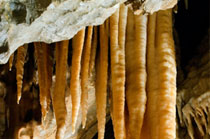
The Bystrianska Cave is the most important cave of the Upper Hron River Valley. It is known by remarkable rocky features and evolution of underground spaces, occurrence of flowstone fills.
| mon | tue | wed | thu | fri | sat | sun |
| 1 | 2 | 3 | 4 | 5 | 6 | 7 |
| 8 | 9 | 10 | 11 | 12 | 13 | 14 |
| 15 | 16 | 17 | 18 | 19 | 20 | 21 |
| 22 | 23 | 24 | 25 | 26 | 27 | 28 |
| 29 | 30 | 31 |
| Cave tour | Adults |
Children 6-15y., handicapped people *1 |
Students, > 60 years *2 |
Photo-Video without using a tripod *3 |
Extra admission *4 |
| Bystrianska Cave | 10,00 € | 5,00 € | 9,00 € | 7,00 € | 50,00 € |
|---|
*1 - Children from 6 to 15 years
*2 - Full-time students - if studying at a university, a confirmation of student status for the current academic year; Persons over 60
*3 - Photo-Video - Taking pictures and short video recording without using a tripod can be accomplished only during cave visit after payment of entrance fee and extra fee for taking pictures. The fluency and safety of cave operation mustn’t be disrupted.
*4 - Extra admission can be enabled by the cave manager on visitor’s request only between the times of regular admissions and after paying the admission fee and extra fee. The fluency of cave operation mustn’t be disrupted.
Visitors are obliged to show the result of negative test, wear a face mask, use hand sanitizer and maintain safe physical distance from other parties.
| Duration | Lenght | Average temperature | |
| Bystrianska Cave | 45 min | 580 m | 5,7 - 6,7 °C |
|---|
The show path is 580 m long and almost flat (26 steps). The visit lasts 45 min. The temperature ranges between 5,7 and 6,7°C.
The cave was formed by tectonical and erosional processes and modelled by underground stream, which flows at present through the spaces 15 to 20 m under the show path. You can see three abysses with the depth of 20 m during the visit. The cave is interesting by diversity of the underground spaces along the tourist path.
| Cave manager: | Ján Vrabec |
|---|---|
| Adress: | 977 01 Brezno |
| Phone: | +421/ (0)48/ 619 51 33 |
| E-mail: | bystrj@ssj.sk |
| District: | Brezno |
|---|---|
| Region: | Banskobystrický |
| Cadastral territory: | Valaská |
| Geomorphological unit: | Nízke Tatry |
| Designation: | Sprístupnené SSJ, Národné prírodné pamiatky |
| Lenght: | 3 531 m |
| Depth: | 99 m |
The cave is located in the ponor zone of the Bystrá-Valaská Karst in the Bystrá foothills of the Horehronské podolie, on the southern edge of the Bystrá village, nearby the recreational resort Tále and on the southern slope of the Low Tatras. Cave entrance is at 565 m elevation above the sea, on the foot of the NW slope of the Chodorov Hill (748 m).
The cave is located on the southern edge of the Bystrá village, between Podbrezová and Mýto pod Ďumbierom. Cave entrance is about 120 m distant from the parking place with minimum vertical difference.
The closest stop of public transport:
Car access to Bystrá village:
 The cave was formed in the Mesozoic Middle Triassic dark grey limestones of the Choč Nappe with chert intercalations. There are also positions of altering pale-grey dolomites. The direction of cave passages is significantly predisposed by steep tectonic faults.
The cave was formed in the Mesozoic Middle Triassic dark grey limestones of the Choč Nappe with chert intercalations. There are also positions of altering pale-grey dolomites. The direction of cave passages is significantly predisposed by steep tectonic faults.
The cave reaches the length of more than 3,531 m with vertical span of 99 m. It was formed by the ponor waters of Bystrianka flowing into the karst territory from the southern slopes of the Low Tatras Mountains in several developmental stages in dependence to the valley bottom deepening. Meander riverbed in the Old Cave is the oldest part of the cave, with an entrance situated 70 m above the present flow of Bystrianka. At present, the ponor watercourse is flowing through the lowest and youngest parts of the New Cave, which are situated 14 m lower than the 160 m distant ponor of Bystrianka in front of the cave. The water course appears also on the bottom of the nearby Bystriansky Doline, which has abyss spaces more than 650 m long and 175 m deep. The springs in Valaská are 3,300 m away from ponors with elevation difference of more than 70 m.
 The main spaces of the New Cave have narrow and high fissure passages widened by corrosion and erosion of the water course. Shorter oval passages are prevailingly predisposed by interbed surfaces and they connect the narrow fissure passages in some places. The upper parts of tectonic faults are widened by corrosion of percolating atmospheric waters in several places. Also larger halls and domes are present, mostly of breakdown character (Collapsed Dome, Mostárenské Halls). The Hell Abyss 70 m deep opens into the lower parts of the New Cave.
The main spaces of the New Cave have narrow and high fissure passages widened by corrosion and erosion of the water course. Shorter oval passages are prevailingly predisposed by interbed surfaces and they connect the narrow fissure passages in some places. The upper parts of tectonic faults are widened by corrosion of percolating atmospheric waters in several places. Also larger halls and domes are present, mostly of breakdown character (Collapsed Dome, Mostárenské Halls). The Hell Abyss 70 m deep opens into the lower parts of the New Cave.
 Flowstone fill is dominated by curtains (Chapel), which sometimes hang from the edge of flowstone crusts formed on previous and later washed out river sediments (Baldachin). Aragonite occurs in places under the Hell.
Flowstone fill is dominated by curtains (Chapel), which sometimes hang from the edge of flowstone crusts formed on previous and later washed out river sediments (Baldachin). Aragonite occurs in places under the Hell.
Air temperature is from 5,7 to 6,7 °C, relative humidity 92 to 98 %. 13 bat species were determined in the cave with the most abundant Lesser Horseshoe Bat (Rhinolophus hipposideros) and Greater Mouse-Eared Bat (Myotis myotis).
 Local people knew about the opening to the Old Cave for a long time. The first people daring to go underground were J. Kovalčík and E. Laubert in 1923. The Hell Abyss, through which the New Cave was reached later, was discovered by E. and A. Hollmann and J. Kovalčík in 1926. The members of the Carpathian Convention from Banská Bystrica continued in cave surveying in 1927. The lower entrance into the New Cave (exit from today’s show path) was opened in 1932. During 1939 – 1940 the Cooperative of Bystrá Caves opened a part of the cave for public but without electrical light. The tragical incident of anti-fascist resistance from the World War II is commemorated by a board in the Collapsed Dome. The Mostárenské Halls in the New Cave were discovered in 1951 under the administration of Turista, national enterprise. The Old and New Cave were connected by J. Majko and J. Vytřísalová with colleagues in 1955.
Local people knew about the opening to the Old Cave for a long time. The first people daring to go underground were J. Kovalčík and E. Laubert in 1923. The Hell Abyss, through which the New Cave was reached later, was discovered by E. and A. Hollmann and J. Kovalčík in 1926. The members of the Carpathian Convention from Banská Bystrica continued in cave surveying in 1927. The lower entrance into the New Cave (exit from today’s show path) was opened in 1932. During 1939 – 1940 the Cooperative of Bystrá Caves opened a part of the cave for public but without electrical light. The tragical incident of anti-fascist resistance from the World War II is commemorated by a board in the Collapsed Dome. The Mostárenské Halls in the New Cave were discovered in 1951 under the administration of Turista, national enterprise. The Old and New Cave were connected by J. Majko and J. Vytřísalová with colleagues in 1955.
The cave has been opened for public in today’s shape since 1968 in length of 580 m.
Dear visitors, visiting the cave requires adequate physical fitness.
The route includes:
- a longer walk in an enclosed darkened area
- reduced temperature and increased humidity
- ascent and descent
- higher number of steps (in some caves)
Special note to persons with medical limitations:
If you suffer particularly from cardiovascular disease, respiratory problems, high blood pressure, mobility limitations or are in poor physical condition, please consider taking part in the tour.
If you have any doubts about the appropriateness of your visit, please consult your doctor about your medical condition.
Your safety is of paramount importance to us.
Thank you for your understanding
Slovak Caves Administration, State Nature Conservation of the Slovak Republic
Dear visitors, we would like to inform you that due to the technical conditions of payment terminals, there may be situations when card payment will not be possible. For this reason, we recommend that you have an adequate amount of cash available if you want to be sure that you will be able to visit the cave. Thank you for understanding.